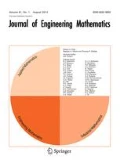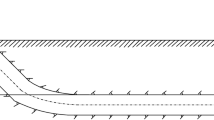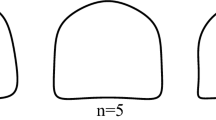Abstract
In geo-engineering, mechanical problems of surcharge loads acting on ground surface and shallow tunnel excavation are often encountered. When the complex variable method is applied, such problems turn to non-zero resultant issues and generally result in infinite displacement singularity in geomaterial at infinity, which violates the fact that displacement components at infinity should be zero in field observations. The displacement singularity at infinity caused by non-zero resultants corresponds non-zero coefficients of logarithmic items in complex potentials. To eliminate the singularity at infinity, the symmetrical method is adopted so that the far-field displacement obtained from the modified displacement solution conducted by the complex variable method would be logically identical to the reality. Two fundamental cases of single surcharge load acting on ground surface and single tunnel excavation are presented to verify the modified displacement solution, and good agreements are observed. The main advantage that the proposed solution eliminates displacement singularity at infinity and makes far-field displacement logically accord with field observation is presented by comparing to the original solution. The drawback that the proposed solution is dependent on modified depth is discussed as well.








Similar content being viewed by others
References
Strack OE (2002) Analytic solutions of elastic tunneling problems. PhD thesis, Delft University of Technology
Muskhelishvili NI (1966) Some basic problems of the mathematical theory of elasticity, 4th edn. Cambridge University Press, Cambridge
Strack OE, Verruijt A (2002) A complex variable solution for a deforming buoyant tunnel in a heavy elastic half-plane. Int J Numer Anal Methods Geomech 26(12):1235–1252
Verruijt A, Strack OE (2008) Buoyancy of tunnels in soft soils. Géotechnique 58(6):513–515
Lu A, Zeng X, Xu Z (2016) Solution for a circular cavity in an elastic half plane under gravity and arbitrary lateral stress. Int J Rock Mech Min Sci 89:34–42
Zeng G, Lu A (2017) Analytical solution for shallow circular tunnel under action of tectonic stress. Rock Soil Mech 38(S1):79–86
Lu A, Yin C, Zhang N (2019) Analytic stress solutions for a lined circular tunnel under frictional slip contact conditions. Eur J Mech A 75:10–20
Fang Q, Song H, Zhang D (2015) Complex variable analysis for stress distribution of an underwater tunnel in an elastic half plane. Int J Numer Anal Methods Geomech 39(16):1821–1835
Wang H, Wu L, Jiang M, Song F (2018) Analytical stress and displacement due to twin tunneling in an elastic semi-infinite ground subjected to surcharge loads. Int J Numer Anal Methods Geomech 42(6):809–828
Fu J, Yang J, Klapperich H, Wang S (2015) Analytical prediction of ground movements due to a nonuniform deforming tunnel. Int J Geomech 16(4):04015089
Fu J, Yang J, Yan L, Abbas SM (2015) An analytical solution for deforming twin-parallel tunnels in an elastic half plane. Int J Numer Anal Methods Geomech 39(5):524–538
Zhang Z, Huang M, Xi X, Yang X (2017) Complex variable solutions for soil and liner deformation due to tunneling in clays. Int J Geomech 18(7):04018074
Zhang Z, Zhang M, Jiang Y, Bai Q, Zhao Q (2017) Analytical prediction for ground movements and liner internal forces induced by shallow tunnels considering non-uniform convergence pattern and ground-liner interaction mechanism. Soils Found 57(2):211–226
Verruijt A (1997) A complex variable solution for a deforming circular tunnel in an elastic half-plane. Int J Numer Anal Methods Geomech 21(2):77–89
Verruijt A (1997) Deformations of an elastic plane with a circular cavity. Int J Solids Struct 35(21):2795–2804
Kong F, Lu D, Du X, Shen C (2019) Elastic analytical solution of shallow tunnel owing to twin tunnelling based on a unified displacement function. Appl Math Model 68:422–442
Chen Z (1994) Analytical method of rock mechanics analysis. China Coal Industry Publishing House, Beijing
Verruijt A (1996) Complex variable solutions of elastic tunneling problems. Technical report, Delft University of Technology
Flamant A (1892) Sur la répartition des pressions dans un solide rectangulaire chargé transversalement. Comptes Rendus de l’Académie des Sci Paris 114:1465–1468
Timoshenko SP, Goodier JN (1951) Theory of elasticity. McGraw-Hill, New York
Wang H, Song F, Liu F (2017) Modified Flamant’s solution for foundation deformation. Mech Eng 39(3):274–279
Schwarz HA (1870) Über einen grenzübergang durch alternierendes verfahren. Vierteljahrsschrift der Naturforschenden Gesellschaft in Zürich 15:272–286
Acknowledgements
This study is financially supported by the National Natural Science Foundation of China (Grant no. 41572253 ).
Author information
Authors and Affiliations
Corresponding author
Ethics declarations
Conflicts of interest
The authors declare that they have no conflict of interest.
Additional information
Publisher's Note
Springer Nature remains neutral with regard to jurisdictional claims in published maps and institutional affiliations.
Appendices
Expanding formulae of the components of the linear system
1.1 Expressions for unknown coefficients
The expressions of \(A_k\) in Eq. (28) are
The expressions of \(B_k\) in Eq. (28) are
where
The expressions of \(W_l (l=1,2,3,\ldots ,6)\) are
1.2 Expressions for components of the linear system
1.2.1 Coefficient matrix
The coefficient matrix in Eq. (35) can be expanded as
where
1.2.2 Solution vector
The solution vector in Eq. (35) can be expanded as
where
1.2.3 Constant item vector
The constant item vector in Eq. (35) can be expanded as
Discussion on symmetrically modified depth (H/h)
As is mentioned in Sects. 3 and 4.2, the value of H, the symmetrically modified depth, would affect the results of modified displacement. To be specific to the case study in Sect. 4.2, it is the value of H/h, the ratio of the symmetrically modified depth to the tunnel depth, that influences the modified displacement. In this appendix, the reason of the value \(H=5.8h\) in the case study will be explained, and the influence of the value of H/h on geomaterial displacement in Sect. 4.2 would be discussed.
The procedure to find the suitable value of H/h is briefly presented below. To be clear, the suitable value of H/h for the case study that makes the modified displacement be approximate to the numerical result is not known beforehand at first. We obtained the horizontal and vertical displacement datum (scattered points) on the ground surface and along the excavation face of the numerical results. Since we already knew the exact displacement expression of the modified solution, except for H, we used the least square method to search the values within the range of \(H/h\in \left[ 2,20\right] \) in several subsections to find the most suitable one for the displacement datum of the numerical results. The criterion is the minimum value of the total sums of all the squares of the difference between the numerical and analytical datum for all four displacement together. The found value of H/h is approximate to 5.836. To be simple, we took it as \(H/h=5.8\).
After obtaining the value \(H/h=5.8\) for the case study, we can discuss the influence of H/h. Figure 9 shows the influence of H/h on displacement components on the ground surface and along the excavation face. The thick black solid lines in Fig. 9 denote the curve of \(H/h=5.8\), which are identical to the ones of “Modified-\(u_x\)” and “Modified-\(u_y\)” in Fig. 7b, d. The red and blue sets of different types of lines in Fig. 9 denote modified displacement datum with H/h larger and smaller than \(H/h=5.8\), respectively. It can be seen that as the value of H/h diverges from the fitted one \(H/h=5.8\), the curves of modified displacement components diverge correspondingly. Comparing Fig. 9a, c to the numerical curves of the horizontal displacement in Fig. 7, it can be found that a larger value of H/h would make the horizontal displacement of the symmetrically modified solution more approximate to the numerical results. Meanwhile, comparing Fig. 9b, d to the numerical curves of vertical displacement in Fig. 7, it can be found that the value of \(H/h\approx 5.8\) makes the curves obtained from the symmetrically modified solution be more approximate to the numerical ones. Thus, Fig. 9 graphically verifies that \(H/h=5.8\) is the suitable value for symmetrically modified solution. Besides, Fig. 9 also illustrates that the symmetrical modified solution is dependent on H, the symmetrically modified depth. Similar findings can be also found in the study by Wang et al. [21].
Rights and permissions
About this article
Cite this article
Lin, Lb., Chen, Fq. & Li, Dy. Modified complex variable method for displacement induced by surcharge loads and shallow tunnel excavation. J Eng Math 123, 1–18 (2020). https://doi.org/10.1007/s10665-020-10047-6
Received:
Accepted:
Published:
Issue Date:
DOI: https://doi.org/10.1007/s10665-020-10047-6





